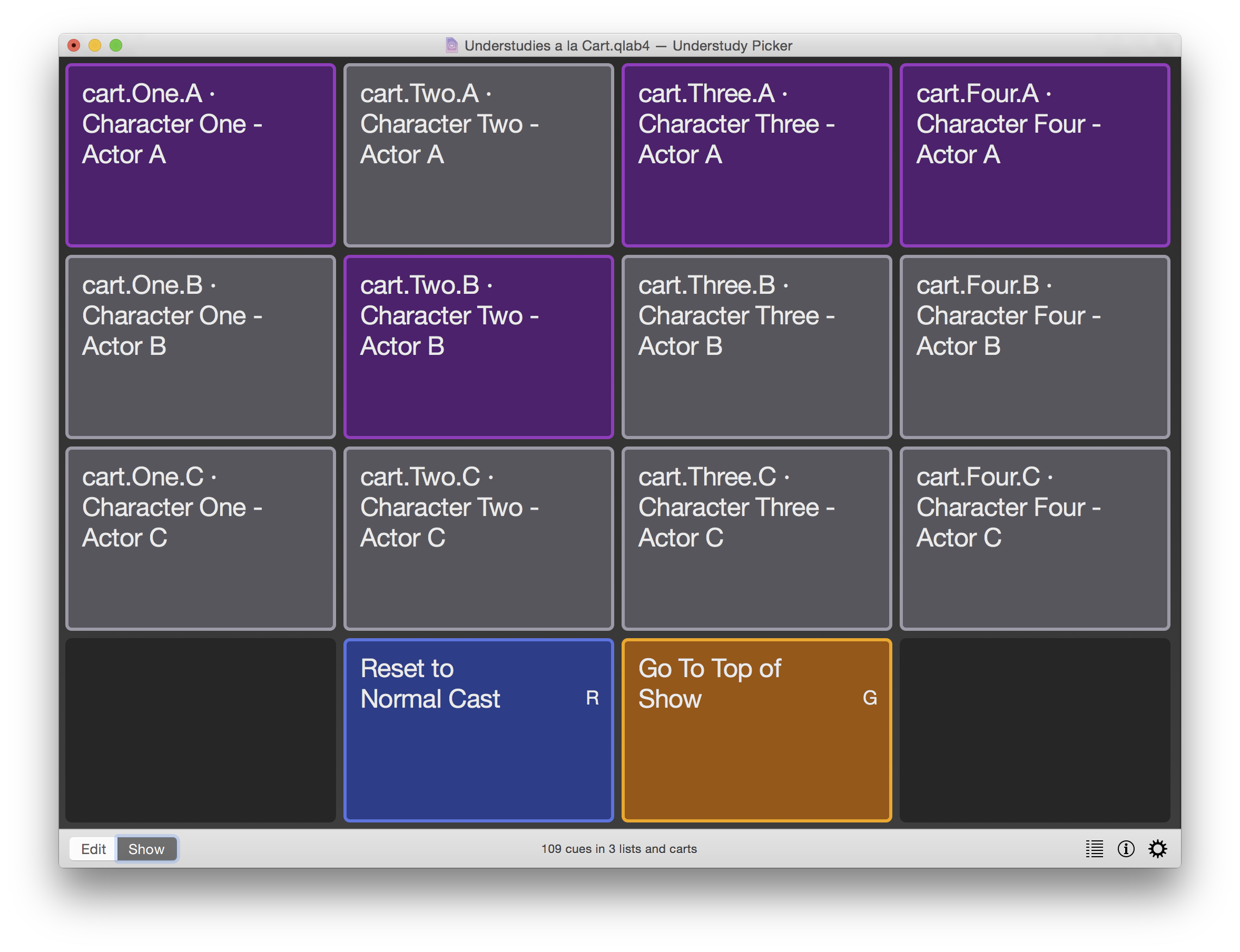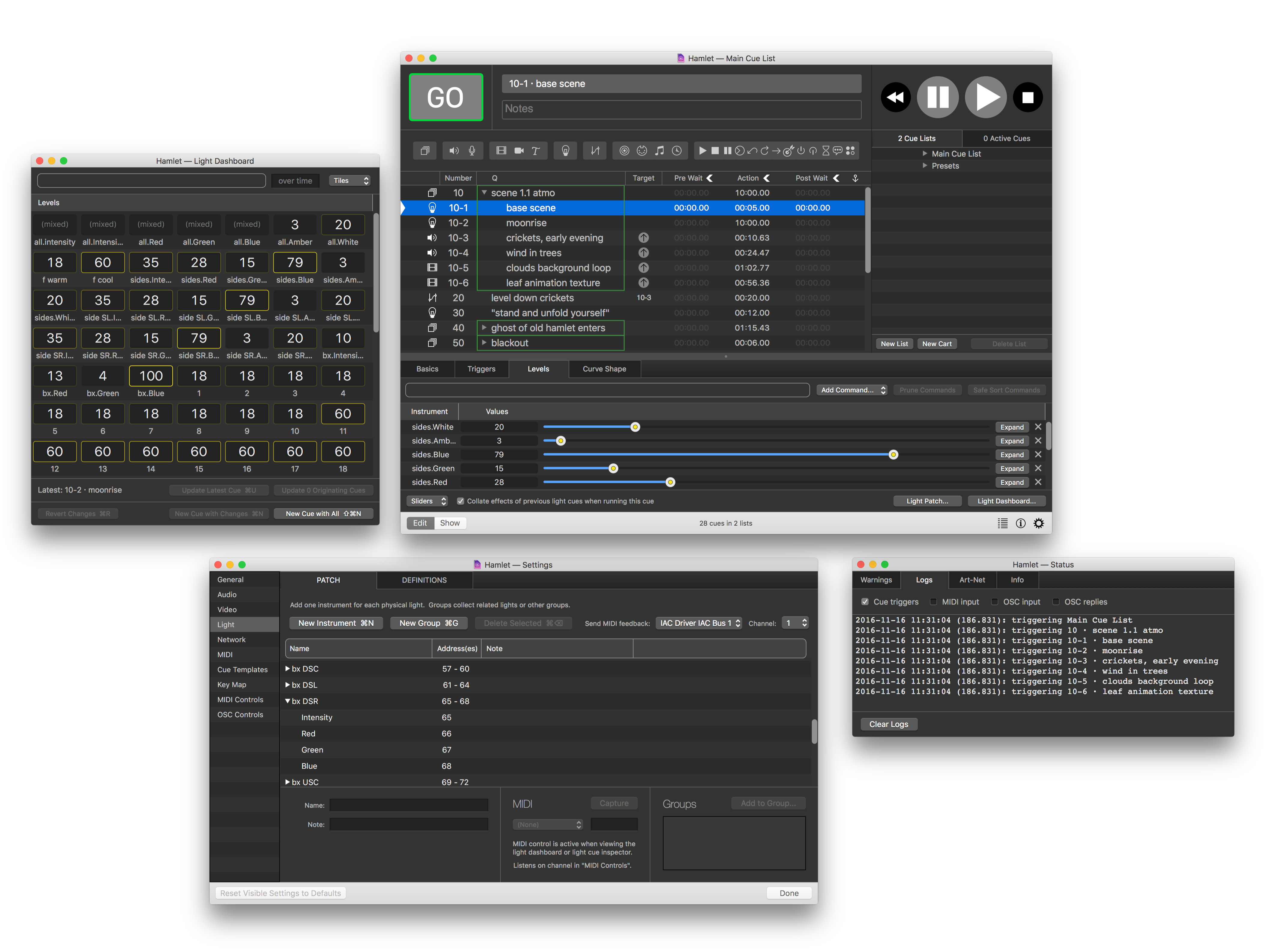Announcing QLab 4.0
Hi, everyone.
We've been working hard on a brand new version of QLab, and we're happy to share it with you today.
We're so pleased to share it, in fact, that we made a little video to introduce you:
What's New
Here are some of my favorite new features in version 4:
Full lighting control
Without a doubt, the biggest new feature in QLab 4 is the new Light cue. QLab can now control your lights directly, using the Art-Net protocol.
Whether you're a seasoned lighting professional or completely new to lights, we've worked hard to make designing your lights simple, powerful, and fun. We've tried to build on important concepts in the field, in addition to breaking some new ground. Version 4.0 is focused especially on providing a great set of tools for controlling conventional lights, but also supports more complex lights with multiple parameters (includes support for percentage-based parameters, as well as both 8-bit and 16-bit direct DMX parameters.)
You can read all about the new Light cue in our extensive lighting user guides.
We're also excited to share some examples of QLab lighting in this space in the days to come, so stay tuned.
Integrated Cue Carts
QLab 4 integrates and expands the features formerly found in our application QCart. With version 4 we are retiring QCart, because QLab now does everything it did, and about a kajillion times more.
(If you are a QCart customer, don't worry, 100% of the purchase price of your QCart license can be applied to a QLab 4 upgrade, if you so desire.)
Cue carts can hold every kind of cue except Group cues, so they're an ideal way to build a super-friendly interface to your design.
For example, here's an example cart that provides quick and easy visual activation of cues based on which actor is playing a role on any given day. It's a great method for handling voiceovers, video cues, or any other sort of cue that needs to change to suit the actor who's on that night. You can even adjust the colors of the buttons based on which actor has been "activated", so it's totally clear that everything is ready for the show.

Massive workflow improvements
To me, the thing that makes QLab QLab has always been workflow. Keeping you flowing smoothly during a design is critical, and we've spent hundreds of hours on improving and expanding how you work in QLab 4.
Your new design toolbox includes:
- Fancy Paste — pasting cue attributes directly onto one or more other cues can save hours of tedious work.
- Record Cue Sequence — run a cue sequence once by hand, so QLab can re-play it again exactly as you did.
- Cue Templates — customize exactly how every cue is created.
- Highlight Related Cues — with this mode enabled, you can instantly see every cue that shares the same target.
- New Status Window — A place to discover everything from exactly what OSC messages you're getting to what Art-Net nodes were found on the network.
- And, of course, a lot more.
Turbo-charged QLab Remote
We're thrilled to release a completely rebuilt, dramatically more powerful QLab Remote for iOS.
QLab Remote now includes:
- An all-new design that looks great on all devices and supports iPad Split View mode.
- Live progress timers for your running cues.
- Customizable UI layout - show, hide, or resize the GO and transport buttons.
- A new "Read-Only Mode" to watch a workspace without worrying about accidentally triggering or editing a cue.
- Edit audio level inputs and crosspoints, not just output levels.
- Attach a keyboard and navigate with shortcuts familiar to QLab power users.
- Browse and select new cue targets, from all the media files in the same directory as your QLab workspace.
- And maybe my favorite new feature: the mobile surface editor, for fine-tuning your video surface control points to get it lined up juuuust right.
Go Make Something Beautiful
We're so glad to finally be able to share this with you, to see (and hear) what you make with it.
And as always, the whole team is here at support@figure53.com to answer questions or just hear your thoughts.
Thanks, everyone.
QLab 4.0 Release Notes
★ Stars denote major new features.
Lighting
Light Cue.
General
Cue carts.
Record sequence tool.
Highlight related cues mode.
"Paste cue properties" aka "fancy paste".
Cue templates.
Support for many new remote editing features when using the new version of QLab Remote.
Status window, which includes: warnings, logging tool, Art-Net node list, general info.
Hotkey for editing cue notes.
Trigger option: fade and stop peers/list/all cues with customizable fade time.
Trigger option: duck/boost volume of other cues in list/cart to given volume level over given time.
Trigger option: second trigger actions, performed when a running cue is triggered a second time.
Trigger option: "perform second trigger on release" for Hotkey, MIDI Note, or cart button triggers.
Batch edit in the inspector for the following tabs: Basics, Triggers, Light Cue Levels.
Support for negative post-wait times, to indicate triggering the next cue "this many seconds before the current one ends”.
Network cue (formerly “OSC cue”) can inject the outgoing message with the current value of (almost) anything in QLab that you can query via OSC.
Network cue OSC messages can be given a duration, over which they re-send their message.
Network cue OSC messages can now be faded over a series of values — both 1D and 2D fades.
Network cues can now be directed to a specific network interface.
Customizable OSC reply formats when using the OSC API.
Group cues in “random” mode now operate in a round-robin manner, where all cues will be triggered before a new round of random cues begins.
Group cues that "start all children" now inherit the duration of their longest child.
Parametric fade curve. (By default, produces equal power audio fade when fading through linear audio domain.)
Control of which domain is used for audio level fades: slider, decibel, or linear.
Option to trigger cue on workspace close, in addition to workspace open
Application preference for what to do on launch:
- restore most recent workspaces - create a new blank workspace - create a new workspace from default template - show the workspace template picker - do nothing
Enhancements to global overrides:
- global input/output overrides can now be set by type of message - new OSC/AppleScript hooks for each override - any cue affected by an override will show a red override status image - a warning now appears in the workspace footer for input or Art-Net overrides
Export broken cues and warnings list as text (via copy to clipboard).
Visible red flash around go button if double-go protection is invoked.
Hold down shift key to insert new cues before instead of after selection.
Temporary duration (tempDuration) for all cues where editing duration is allowed - accessible via AppleScript and OSC.
A currentDuration read-only property (AppleScript and OSC) that returns the current duration of the cue, accounting for any tempDuration that has been set.
Many new OSC API hooks, and a new special address to talk to "active" (running or paused) cues.
Audio
Support for up to 64 audio output channels (up from 48).
Minimum slice time has been reduced to 0.05 seconds (down from 0.1).
The integrated fade envelope can now be locked to the start/end time of the cue instead of the file.
Mic cues can now use specific channels of the input device.
Audio cues watch their target files for changes and update automatically.
Duck/boost volume of other cues in list/cart to given volume level over given time.
Video
Editable durations for still image Video cues and Text cues.
Copy/paste surface geometry in video settings.
Video facets are now anchored to their center points when they change size.
Improved color accuracy of video cues and effects.
Basic support for using files that use the Hap video codec.
